Post Growth: Baruch Gottlieb
“I see the art space as having a unique role to play in society today, particularly in providing a sort of safe space for the cultivation of new social and cultural practices which are needed to confront the challenges of our age.”
Baruch Gottlieb is a Canada-born media artist, researcher, and curator. He currently teaches Philosophy of Digital Art at the Berlin University of the Arts and Data Epistemology at the Technical University of Brandenburg. Gottlieb has been working closely with DISNOVATION.ORG since he collaborated on the project Online Culture Wars (2018-19). He is also a member of the Telekommunisten and Arts & Economic Group artist collectives. His books include A Political Economy of the Smallest Things (ATROPOS 2016) and Digital Materialism (Emerald 2018).
Q: You co-collaborated on almost all of the works in Disnovation’s current exhibition at iMAL. What’s your personal interest in the concept of post-growth?
A: It comes from my interest in how images function in society and observations on how increasingly complex phenomena, such as in economics or climate data, are represented in common discourse. I see a role for artists to intervene, to interpret scientific data in a proactive manner to attempt to support the kinds of political catalysis we wish to see in the world. In the case of the climate crisis, we need to confront the enormous power of think tanks and lobby groups that persuade people to look the other way as the climate emergency is largely disregarded. I was at a conference where Merkel’s top climate consultant Hans Joachim Schellnhuber stated that the expertise and knowledge exist to ensure that everyone alive on the earth right now can enjoy good living conditions and that the climate crisis can be successfully addressed, but what was missing was the political agency to instantiate that expertise and knowledge. As artists, we agreed to do our part to try to cultivate new vectors for people to come together and generate social agency.
Q: How important is collaboration both in your own work and to solving some of the problems outlined in the exhibition?
A: I come from filmmaking which is traditionally a very multidisciplinary form of art. Each production is the result of the communication and collaboration of diverse specializations and talents, from make-up to lighting, camera, acting, and editing. Even though I have broadened my artistic practice, I still operate more or less as I did as a filmmaker, working with diverse teams of specialists to produce what I could not do on my own. Collaborations and collectives are very common in media art because the works are often very complex and require a lot of specialist knowledge. As part of my curatorial practice, especially over the past three years at the museum West Den Haag, I have organized a variety of transdisciplinary projects from summer schools to symposia where I am consciously developing methods to generate synthetic forms of thinking and creation across conventional disciplinary boundaries. Now, with the Post-Growth project, we are attempting to integrate the pure sciences on their own terms. Besides working with Disnovation, I also am a core member of telekommunisten where we work to help demystify network infrastructure and help people understand the political economy behind what they experience through their networked devices.
“I see the pretext of our exhibitions and other activities as centrifuges of scientific knowledge, allowing us to assemble otherwise unlikely constellations of specialists around urgent concerns. So far, this strategy seems to be working.”
Q: Why address this topic in the form of an exhibition? What role do artists and art institutions have in addressing climate change?
A: As I mentioned earlier, I see the art space as having a unique role to play in society today, particularly in providing a sort of safe space for the cultivation of new social and cultural practices which are needed to confront the challenges of our age. These new practices may include artistic practices and artworks, but they are also themselves art.
Q: What do the scientists and researchers think of the exhibition? Is there a way that they can borrow some of the models you’ve used to feedback into their own work?
A: The proof is in the pudding. We develop our models in intense consultation with scientists, but at a certain moment, we need to make works for an art exhibition, hoping and expecting that they will be interested in coming over and critiquing these so that we may improve them, and, judging from the iMAL show, they are. I see the pretext of our exhibitions and other activities as centrifuges of scientific knowledge, allowing us to assemble otherwise unlikely constellations of specialists around urgent concerns. So far, this strategy seems to be working, and we will develop this more in Disnovation’s residency at the University of Louvain la Neuve where we will be working with specialists from agronomy to economics and data science.
Post Growth
Life, After the CrashExplore more of "Post Growth:"
→ HOLO.mg/stream/
→ HOLO.mg/imal-post-growth/



